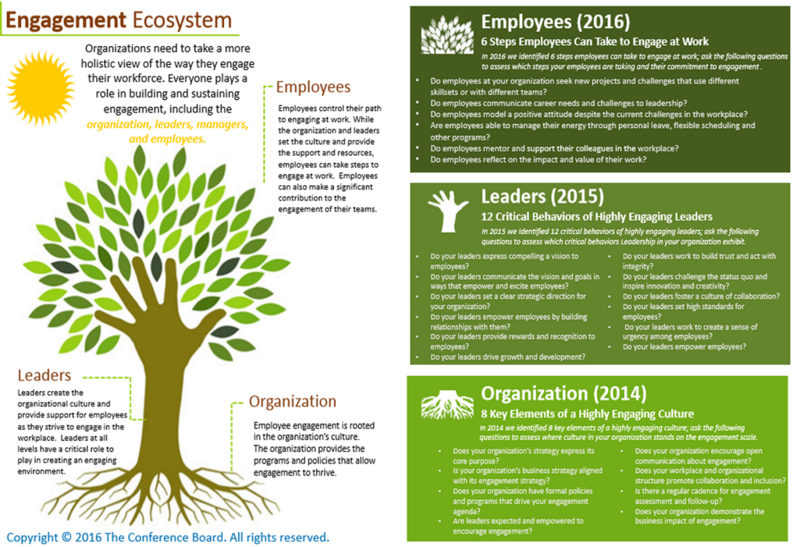ATD Blog
Getting Employee Engagement Right Takes More Than a Village
Thu Apr 20 2017

Despite increasing investments in employee engagement surveys, programs, and interventions, fewer than one third of workers around the globe are engaged, resulting in high levels of commitment and discretionary effort. In many parts of the world, and especially in some industries, the percentage is even lower. Yet, we’ve seen organizations succeed with highly engaged employees who are more productive and innovative and who deliver performance that matters. There are bright spots.
Consider the Detroit, Michigan-based company Quicken Loans. Its employees, guided by cultural touchstones they embrace from Day 1, deliver award-winning mortgage processing services to raving customers. These employees also lift their communities and help Quicken Loans lead the recovery effort in Detroit, which has led to its current Renaissance. Another company to watch is the Mayo Clinic, whose physicians, specialists, nurses, and support personnel come together as an aligned, engaged, high-performing team with one purpose: put patients first. By fulfilling this mission, employees create medical miracles. What’s more, patient deaths rates and physician and caregiver burn-out rates decrease.
Talk to employees at either organization and they tell stories of the mission that they are on, the impact they believe they personally make, and how privileged they feel to work there. That’s engagement, and it’s palpable.
DNA of Engagement
If achieving and sustaining high levels of employee engagement is possible, why can’t more of us get this right?
For the last three years at The Conference Board, we’ve been on a journey at The Engagement Institute to better understand how highly engaging cultures are forged, how highly engaging leaders are supported, and how employees can and should play an active role in their own engagement. Every year, the institute brings together executives who are passionate about employee engagement from a cross section of industries and who seek to enhance the conversation around employee engagement.
These executives, along with researchers from Sirota/Mercer, Deloitte, and The Conference Board, have profiled dozens of organizations, interviewed the leaders of iconic firms known for engagement, fielded custom surveys receiving thousands of responses, held focus groups with hundreds of managers and employees, visited highly engaged organizations to hear directly from employees and leaders. Then, they distilled the wisdom into a series of three DNA of Engagement reports and related diagnostic tools. While the full reports provide a deep analysis of the work, here’s a quick primer on what was found.
Just who in the organization is responsible for creating an engaging culture? Senior executives? Human resources professionals? Frontline supervisors? Employees? The short answer is everyone! It takes more than a village, it takes an ecosystem. Here’s how to think of the interconnected elements and conditions that must be in place for engagement to flourish and grow along with the kinds of questions that should be part of everyone’s checklist.
Figure 1. The Engagement Ecosystem

The Engagement Ecosystem We found in our first year of working together that highly engaging cultures get several critical elements consistently right, such as:
alignment of business and engagement strategy
formal programs that drive the engagement agenda
proactive, leader-led communication about engagement
a physical or virtual workplace that promotes collaboration and innovation
leaders who are expected and empowered to build engagement.
In year two, we learned that there are 12 behaviors of highly engaging leaders. These include building trust and acting with integrity, developing a compelling vision, creating a sense of urgency, and driving development and growth for their people, to name a few. More important, this year, we discovered the six steps employees can take to engage at work. We asked: What defines taking personal responsibility for work? The Engagement Institute defines employee ownership of engagement as employees “proactively taking personal responsibility for creating, sustaining, and displaying positive attitudes, mindsets, behaviors, and motivation at work.” To further understand what drives employees to take on this responsibility, we examined four research questions:
Are employees with certain personality profiles more likely to own their own engagement?
Do specific job characteristics encourage employees to own their own engagement?
Do certain leadership and management practices encourage employees to own their own engagement?
Do certain organizational culture qualities affect the extent to which employees own their own engagement?
Several insights on fostering employee ownership of engagement emerged. First off, most employees are committed to taking responsibility for their own engagement, and those who do are more engaged. Almost all employee respondents (96 percent) report they try to maintain a high level of engagement at work and are aware when they begin to feel disengaged. Nevertheless, only 81 percent of respondents indicated: “I regularly seek ways to make sure I am engaged.”
When feeling disengaged, one in four employees do not actively take steps to re-engage themselves at work. According to focus group participants, those who take personal responsibility for engagement tend to have a positive outlook, take on new opportunities, seek new challenges, believe it is their role to shape the culture and workplace environment, find the connection between their work and the big picture, and help develop solutions for common challenges in the workplace.
In addition, both personal and organizational factors affect the extent to which employees take responsibility for their own engagement. Employees with proactive personalities and strong learning orientations perform better in managing their own engagement. Well-designed jobs that constantly fuel employees with a sense of accomplishment enable employees to find ways to stay engaged. Also, employees working under the leadership of managers who are trustworthy and open to feedback will more actively take steps to re-engage themselves at work.
Finally, a workplace culture that promotes a compelling mission and fosters a sense of community and belonging has a notable impact on driving employees to take personal responsibility for engagement.
Steps to Re-Engage
Here’s the good news: employees can take specific steps to re-engage at work. The actions employees can take include:
reflecting on the impact of their work
communicating career needs to leadership
managing their own energy
taking on new and challenging assignments.
Modeling a positive attitude at work and mentoring colleagues are also effective engagement approaches that can help employees to not only recharge their own sense of commitment, but also create an engaging environment for their teams.
What can managers and leaders do? To create an environment where employees are more comfortable and take responsibility for their engagement, managers can:
connect employees’ work to the mission of the organization
promote a collaborative team environment
communicate with employees regularly on their performance and career goals
empower them through delegating responsibilities
remove barriers to help them succeed.
It is also essential to recognize employees for the value and impact they add to the organization.
This begs the question: What can organizations do? For starters, human capital executives should weave the mindset of employee ownership of engagement into relevant initiatives in every step in the lifecycle, including recruiting, hiring, and onboarding employees; training and developing employees; and transitioning departing employees.
Meanwhile, senior leaders can articulate the importance of engagement and the organization’s journey to create a culture that is a beacon to candidates, a work environment that employees will be reluctant to leave for fear of not finding another such place, an unbreakable bond with customers and a valuable partner to community stakeholders.
Like any ecosystem, it’s a delicate balance and it requires all elements to work together toward a common goal: better business performance through that very rare forest creature, the highly engaged employees. You can learn more by reviewing the report. Better yet, come join us on this journey at The Engagement Institute!
